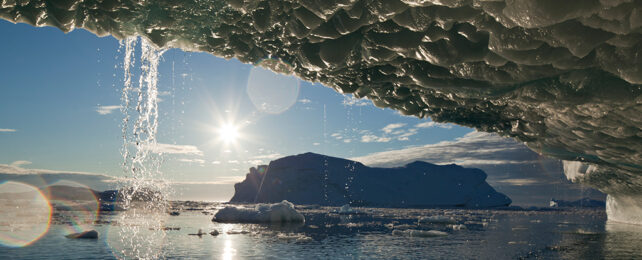Earth's rapid defrosting is putting our ecosystems and our own personal health at risk of a litany of threats, including a slew of potential pathogens that may once have wreaked havoc among our ancestors.
As reported by Newsweek's Pandora Dewan, scientists are increasingly concerned that viruses successfully reawakened after tens of thousands of years preserved in permafrost could be a sign of worse things to come.
"There is a Factor X that we really don't know very much about," Umeå University infectious disease specialist Birgitta Evengård told Dewan.
As speculative as such future threats happen to be, what researchers have uncovered in recent years warrants serious consideration into improving surveillance and investigation of potential spillover events in the Arctic.
Thanks to the very way infectious diseases work, most epidemics are likely to come from a novel source, such as a population of wild animals. Studies have shown outbreaks of zoonotic diseases are on the increase, both in number and in diversity, with deaths expected to continue to rise by an average of nearly 10 percent each year.
Statistics like these don't even take into account spikes caused by catastrophic events like COVID-19, which are also expected to occur with greater frequency as the climate shifts and humans encroach on a greater diversity of animal habitats.
While history can tell us a thing or two about diseases spilling across from one host to another through space, the possibility of a pathogen making a giant leap through time is new territory for researchers.
Yet there are solid reasons to suspect it's possible, and even likely.
In 2016, anthrax was reportedly responsible for the deaths of more than 2,000 reindeer and a single person in the sparsely populated Yamalo-Nenets district of northwest Siberia. The origin of this particular outbreak is thought to be an infected animal carcass, one that had been long frozen in the Siberian ice.
The bacterium responsible for the disease, Bacillus anthracis, has evolved a talent for hibernating in the form of a spore, with another species in the same genus being revived in the laboratory following tens of millions of years of preservation inside a bee trapped in amber.
Viruses can have a similar knack for sleeping away the centuries. Just last year, researchers reported on the revival of a 50,000 year old amoeba virus found in frozen sediment 16 meters (52 meters) below a Russian lake.
What these laboratory studies have to say about the chances of real-world viral infections is hard to say. While viruses require the right 'machinery' to latch onto host cells and replicate inside, there's no clear rule about the evolutionary relationship between two potential hosts, making it hard to predict just how susceptible we might be to a pathogen based on what they infected in the past.
On the other hand, the rate and intensity of contact with a virus might make all the difference in whether it eventually evolved a means of infecting a new host. Dump enough microbes into a shared ecosystem over a short time frame, there's a chance at least one might find a new host to infect.
Researchers from the University of Ottawa used DNA and RNA sequencing to build a picture of the kinds of viruses found in the soil and water of Lake Hazen, the largest freshwater lake in the High Arctic. Their study, published in 2022, suggests the frozen north could become "fertile ground for emerging pandemics" as ice continues to melt.
Measuring the overlap between the family trees of the viruses and potential hosts, their investigation showed the chances of a spillover of trapped viruses into a known susceptible host population rises as the rate of glacial melt increases.
While a return of smallpox, the next coronavirus, or some completely novel kind of virus known only to our distant ancestors are all terrifying possibilities, the chances a pathogen might emerge that influences critical parts of a food web can't be dismissed either; either as an agent of infection or as a source of carbon itself.
Knowing what we do, there are almost certainly unknown factors contained in long-frozen ice that could take us by surprise.
Evengård's message to Dewan is one that bears repeating. "There is a lot we don't know, and what very few people have looked into is the permafrost."
